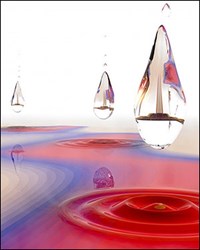Quantum Droplets Form In Laser-Shot Semiconductors

The accidental discovery of a new quasiparticle that behaves like a drop of liquid could provide a better understanding of solid-state devices such as semiconductors and superconductors.
Scientists at the University of Colorado made the discovery during extremely low-temperature semiconductor and laser experiments. Described as a quantum droplet, scientists are calling the quasiparticle a dropleton. It has properties unlike anything seen before, they said.
The research team cooled a gallium-arsenide semiconductor to –263 °C and shot it with ultrafast laser pulses. This generated free electrons and holes, which, when combined, will form excitons. Increasing the laser’s intensity created more and more excitons, weakening the bond between their electrons and holes — at a certain heat and intensity, excitons can no longer form.
After reducing the wavelength of the laser, excitons were created, but this time the excitons came together into quasiparticles called biexcitons. Similar to excitons, scientists expected the biexcitons’ bonds to weaken with increased laser intensity.
“Then we noticed something very peculiar,” said Steven Cundiff, a physicist at the University of Colorado and NIST.
The biexcitons actually became more strongly bound, seeming to form a completely new configuration of electrons and holes. In the excitons, the electrons and holes were forming something similar to hydrogen atoms, while the biexcitons acted like hydrogen molecules. In this new quasiparticle, the electrons and holes no longer had a fixed position relative to one another. Instead, they jostled like a small drop of liquid.
“We were puzzled,” Cundiff said. “Hydrogen atoms don’t do this.”
But by performing different control experiments, the team was able to eliminate the possibility that what they were seeing corresponded to any other known quasiparticles.
They also compared it with some mathematical models before realizing that they had discovered something completely new.
The researchers plan to continue studying this new quasiparticle.
For more information, visit www.colorado.edu.
Source: University of Colorado
